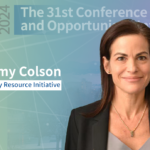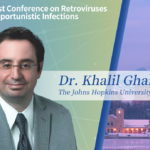
Editor's Note: Antiretroviral therapy (ART) has significantly extended the lifespan and improved the quality of life for HIV-infected individuals, yet achieving a complete cure for HIV remains an unresolved challenge. HIV's characteristic of latent infection allows it to persist in the body, hidden from the immune system, and reactivate upon cessation of ART. Thus, developing a curative therapy capable of entirely eliminating the virus from the body and achieving long-term virus-free survival is a critical need in medical science. At the recent 2024 Conference on Retroviruses and Opportunistic Infections (CROI 2024), Infectious Disease Frontier had the privilege of interviewing Dr. Afam A. Okoye from the Vaccine and Gene Therapy Institute, Oregon National Primate Research Center, Oregon Health & Science University. He provided insights into the research highlights in the field of HIV curative therapies at the conference and shared his views on cutting-edge technologies such as latency reversing agents, cytokine research, and gene editing.Infectious Disease Frontier: Could you please share us what Presentations in HIV Cure impressed you at this CROI congress?
Dr. Afam A. Okoye: This conference has a lot of presentations focused on HIV cure and we know HIV cure research is very diverse. It ranges from latency reversing agents so these are molecules or could be antibodies, could be adjuvants, anything that can increase the amount of RNA expression in vivo. And so there are a lot of talks, a lot of presentations on new latency reversion agents that have been presented.
I think some of the more exciting ones are using targeting tat, which is a viral protein that is important for enhancing viral transcription and elongation. And now there are a few novel techniques are approaches that have been investigated to be able to target tat to infect the cells in vivo and particularly using small molecules using mRNA technology and so some of these talks are really exciting and we’re looking forward to seeing them.
There’s also a lot of work on cytokines as well, and the role of IL-15 as a cytokine to enhance immune function to hopefully facilitate control of the virus after ART is stopped. So there’ll be a presentation on that as well as therapeutic vaccines and there will be a talk on mRNA based therapeutic vaccines that will be coming up. And then there’s also gene editing. So there’s going to be a really exciting talk on AAV mediated expression of broadly neutronized antibodies in infants non human primates and this is believed to actually prevent rebound virus occurring. So these are really exciting things i think that technology is going to the place where we’re actually beginning to see evidence that potentially we can see signals that will lead us to a potential cure.
Infectious Disease Frontier: Do you think hematopoietic stem cell transplantation therapy will be promoted as a cure therapy for HIV in the future?
Dr. Afam A. Okoye: Under certain conditions. So in people who have hematologic malignancies who will require it if they are living with HIV, then it would make sense that that would be part of their treatment protocol. For this group of people, it is possible to try to obtain a transplant from the donors who are resistant to HIV with a CCR5-delta 32 mutation. But for people who don’t have hematologic malignancies, I see that as unlikely as being a widespread cure because it’s a very aggressive and very high risk procedure and it’s unlikely that, especially in low and middle income countries, that you can be able to to enrol that as a widespread cure.
Infectious Disease Frontier: Currently, there are still many HIV curative therapies under development. Which therapies do you think show good application prospects?
Dr. Afam A. Okoye: Well, it’s hard to pinpoint one particular therapy in general but I think overall it’s clear that what we have to do is look for ways to not only reduce the amount of latently infected cells that persist. So targeting them in a way either with a latency reversing agent or neutralizing antibody or we’re going to be hearing about CD4 mimetics at this meeting. So CD4 mimetics these small molecules that if envelope is expressed on an infected cell, it changes the confirmation of that of envelope and it allows that cell to not be recognized by antibodies that could mediate ADCC. So we definitely have to find ways to reduce the amount of virus to persist and I think that that that we’re beginning to develop those novel approaches but after that it’s not going to be enough. And so really I think for cure it’s all about combination. We reduced the reservoir, but we have to combine that with a technique to protect cells from infection either using gene editing or long acting antivirus. Then we also have to make sure that the immune system is ready to respond in case the virus comes back out again.
So I think combining all those things with vaccines, adjuvants, etc. is the future. And that’s the way I think the field is moving and we’re beginning to see a lot more human clinical trials that are focused on these combination agents looking at vaccines in combination with with latency reversing agents in combination with strategies to enhance control. So I think that’s the future.

Dr. Afam A. Okoye
Associate Professor, VGTI-Vaccine and Gene Therapy Institute
Oregon National Primate Research Center
Oregon Health & Science University


